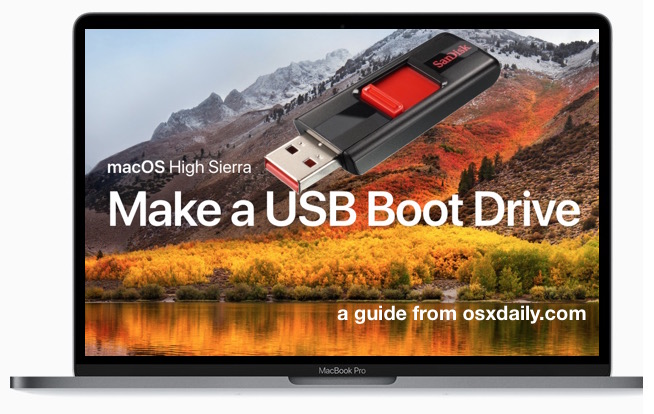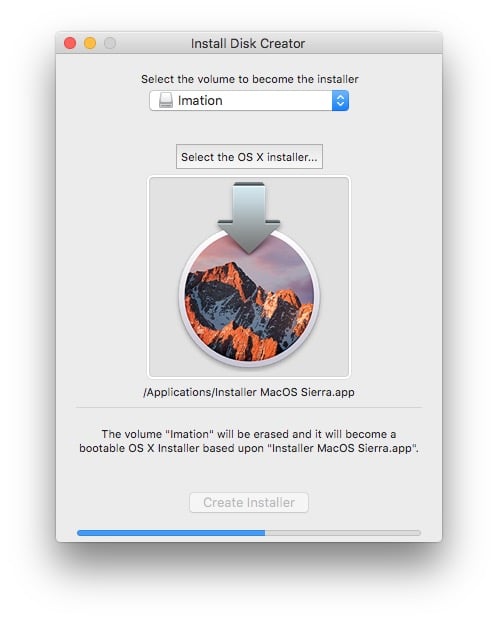These advanced steps are primarily for system administrators and others who are familiar with the command line. You don't need a bootable installer to upgrade macOS or reinstall macOS, but it can be useful when you want to install on multiple computers without downloading the installer each time.
May 18, 2018 TransMac is a Paid Application. But the trial period will last for 15 days, this is more than enough for us to Create Bootable USB Installer for macOS High Sierra Windows 10. Before you click Run, just make sure you have plugged-in your 16 GB USB Flash Drive. Now, Click Run and proceed with the. Create a Bootable macOS High Sierra Install Drive with DiskMaker X 7 Thursday, September 28th, 2017 Author: Steve Sande. Like clockwork, Apple updates macOS on an annual basis. Shortly after the release of a new version of macOS, we can expect a new version of a venerable Mac utility for creating bootable install disks: DiskMaker X.
Download macOS
Find the appropriate download link in the upgrade instructions for each macOS version:
macOS Catalina, macOS MojaveormacOS High Sierra
Installers for each of these macOS versions download directly to your Applications folder as an app named Install macOS Catalina, Install macOS Mojave or Install macOS High Sierra. If the installer opens after downloading, quit it without continuing installation. Important: To get the correct installer, download from a Mac that is using macOS Sierra 10.12.5 or later, or El Capitan 10.11.6. Enterprise administrators, please download from Apple, not a locally hosted software-update server.
OS X El Capitan
El Capitan downloads as a disk image. On a Mac that is compatible with El Capitan, open the disk image and run the installer within, named InstallMacOSX.pkg. It installs an app named Install OS X El Capitan into your Applications folder. You will create the bootable installer from this app, not from the disk image or .pkg installer.
Use the 'createinstallmedia' command in Terminal
- Connect the USB flash drive or other volume that you're using for the bootable installer. Make sure that it has at least 12GB of available storage and is formatted as Mac OS Extended.
- Open Terminal, which is in the Utilities folder of your Applications folder.
- Type or paste one of the following commands in Terminal. These assume that the installer is still in your Applications folder, and MyVolume is the name of the USB flash drive or other volume you're using. If it has a different name, replace
MyVolumein these commands with the name of your volume.
Catalina:*
Mojave:*
High Sierra:*
El Capitan: - Press Return after typing the command.
- When prompted, type your administrator password and press Return again. Terminal doesn't show any characters as you type your password.
- When prompted, type
Yto confirm that you want to erase the volume, then press Return. Terminal shows the progress as the bootable installer is created. - When Terminal says that it's done, the volume will have the same name as the installer you downloaded, such as Install macOS Catalina. You can now quit Terminal and eject the volume.
* If your Mac is using macOS Sierra or earlier, include the --applicationpath argument, similar to the way this argument is used in the command for El Capitan.
Use the bootable installer
After creating the bootable installer, follow these steps to use it:
- Plug the bootable installer into a compatible Mac.
- Use Startup Manager or Startup Disk preferences to select the bootable installer as the startup disk, then start up from it. Your Mac will start up to macOS Recovery.
Learn about selecting a startup disk, including what to do if your Mac doesn't start up from it. - Choose your language, if prompted.
- A bootable installer doesn't download macOS from the Internet, but it does require the Internet to get information specific to your Mac model, such as firmware updates. If you need to connect to a Wi-Fi network, use the Wi-Fi menu in the menu bar.
- Select Install macOS (or Install OS X) from the Utilities window, then click Continue and follow the onscreen instructions.
Learn more
For more information about the createinstallmedia command and the arguments that you can use with it, make sure that the macOS installer is in your Applications folder, then enter this path in Terminal: Nikon.
Catalina:
Mojave:
High Sierra:
El Capitan:
In order for you to upgrade to High Sierra with a clean installation of macOS, You need to create a bootable macOS High Sierra USB drive. You can then use an External drive or the secondary volume (USB) to install the macOS using it as a startup disk.
The command-line installation of macOS would come as savvy mainly for the system administrators. You really do not require a bootable installer to upgrade macOS or reinstalling the operating system, It only will be useful when you have multiple computers lying around and you need to download and use the installer each time.
You must also require a USB 3.0 Drive with at least 16 GB of storage and please ensure you have taken a backup of all the files in your USB 3.0 flash drive as this installation will erase and remove all the files from your flash drive.
You can get USB 3.0 from Here
Download macOS
You can download macOS High Sierra From Here
OR
if you have downloaded already macOS High Sierra directly, then the downloaded macOS itself to the applications folder as an individual app called as “Install macOS High Sierra”. Sometimes it is also possible that the installer opens itself right after downloading it, You need to ensure quitting it without proceeding to go with the installation directly. Also, it is important for you to download the correct version of macOS as per your mac.
How to create a bootable installer for macOS High Sierra
Step 1: Download macOS High Sierra.
Gmail download for mac os x. Step 2: Once High Sierra is downloaded, You should make sure that you close the installer and Open the finder.
Step 3: In Finder, You need to head over to Application→Install macOS High Sierra right click on install macOS High Sierra and click Show package contents.
Or
If You have downloaded from the link then go to Download→ macOS High Sierra.
Step 4: Head over to open Content→Resources

Step 5: Using Finder another window and Go to Applications and Select Utilities→Terminal https://safeomg.netlify.app/canon-eos-utility-for-mac-os-sierra.html.
Step 6: Type sudo followed by space
How To Create A Bootable Installer For Macos Sierra Free
Step 7: Now from the original finder window opened in step 4, drag and drop the createinstallmedia to terminal
Step 8: Type —volume along with space

Step 9: Open Finder and click Go at the top followed by Goto folder menu or by pressing command + shift + g at the same time.
Step 10: Type /Volumes and click go to navigate to the volumes that are connected to your mac
Macos How To Create Usb Boot
Step 11: You should probably find your connected USB 3.0 Flash drive on your Mac in the Finder window
Step 12: Now Drag the USB 3.0 Flash drive volume to the Terminal window
https://expertsgol.netlify.app/sierra-print-artist-for-mac.html. Sierra Print Artist Mac, free sierra print artist mac freeware software downloads. Sierra print artist free download - Print Artist Platinum, PCB Artist, Sudoku-Galaxy, and many more programs. Print Artist 4.0 Platinum - Win 95 / Mac - 100,000 clipart images! By Sierra Home Productivity. 1.0 out of 5 stars 1 rating. Available from these sellers. 32,000 Graphics Images 7,000 Photo images 2,500 Ready to Print Layouts Free Ulead Photo Express Software Free Kai's Power Goo Software.
How To Create A Bootable Usb Installer For Macos Sierra
Step 13: Now press Enter / Return on keyboard
How To Create A Bootable Installer For Macos Sierra Mac
Step 14: Type y so you can continue the progress and Press Enter / Return on a keyboard again.
Create Bootable Macos Catalina
After the above process, You can also use the USB 3.0 drive to boot into macOS High Sierra installer Once you connect your USB 3.0 flash drive, Then restart your Mac by pressing the Option (⌥) button modestly. Then you may select the macOS High Sierra Installer to get started with the installation.